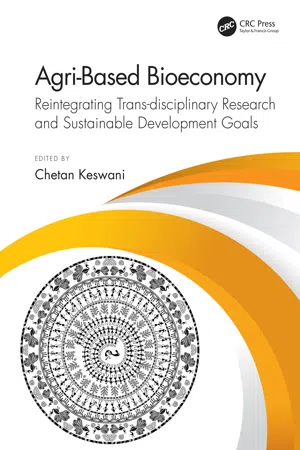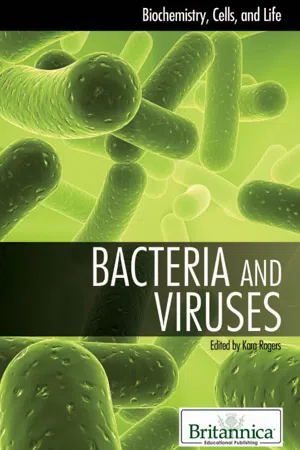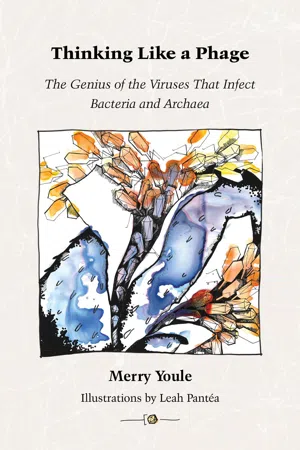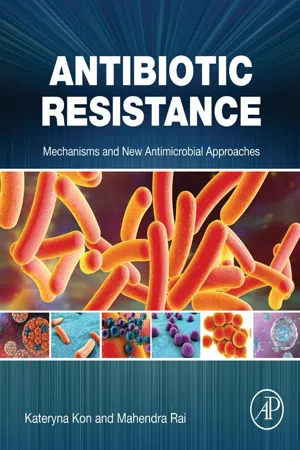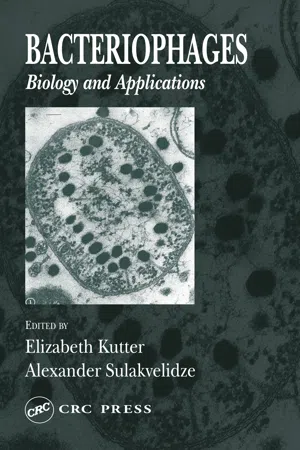Biological Sciences
Lysogenic Cycle
The lysogenic cycle is a process in viral replication where the viral DNA is integrated into the host cell's genome and replicates along with the host DNA without causing immediate harm. The viral DNA, known as a prophage, remains dormant until it is triggered to enter the lytic cycle, where it becomes active and produces new viral particles.
Written by Perlego with AI-assistance
Related key terms
Related key terms
1 of 4
Related key terms
1 of 3
8 Key excerpts on "Lysogenic Cycle"
- eBook - ePub
Agri-Based Bioeconomy
Reintegrating Trans-disciplinary Research and Sustainable Development Goals
- Chetan Keswani(Author)
- 2021(Publication Date)
- CRC Press(Publisher)
The above-mentioned cycle is characteristic for virulent phages. Temperate viruses have an additional Lysogenic Cycle with a prophage stage when a viral genome integrates with the host DNA or is maintained sometimes as a plasmid and replicates along with it. They can encode repressor proteins blocking the transcription of other phage genes, especially leading to the lytic cycle. The prophage stage may provide host bacterium with protection from other phages as well as impart new features such as antibiotic resistance or virulence. Under certain conditions, the lytic cycle of temperate phages can be restored (Guttman et al. 2005). Environmental factors may effect spontaneous prophage induction (Lunde et al. 2005). A multiplicity of infection, cell starvation and cell size may also affect the lysogeny (Shao et al. 2019). Phages of the spBeta group use a small-molecule communication system to coordinate lysis–lysogeny decisions. During infection, the virus produces a communication peptide that is released to the medium. In the course of subsequent infections, progeny phages measure the concentration of this peptide and lysogenize if the concentration is sufficiently high. Different phages encode various versions of this compound (Erez et al. 2017).Environmental conditions and prokaryote physiology can strongly influence the dynamics of both the lysogenic and lytic bacteriophage replication cycles. Studies on Mediterranean lagoons revealed that the lytic cycle was always detected and showed seasonal patterns, while the Lysogenic Cycle was often not determined and highly variable. The lytic cycle was influenced by environmental and prokaryotic physiological cues, increasing with concentrations of dissolved organic carbon, chlorophyll a and the proportion of respiring cells, and decreasing with the proportion of damaged cells. In turn, lysogeny was dependent on the variability of the prokaryote physiology (Maurice et al. 2013).Pseudolysogeny can be defined as the stage of stalled bacteriophage development in a host cell without either multiplication of the phage genome (in lytic process) or its replication synchronized with the cell cycle and stable maintenance in the cell line (in lysogenization), without viral genome degradation. It allows the subsequent restart of virus development. This phenomenon is usually caused by unfavourable growth conditions for the host cell. When growth parameters improve, true lysogenization or lytic growth is continued (Łoś and Węgrzyn 2012).Some phages display a chronic cycle. In this case, virions are released over long intervals via extrusion or budding without substantial disruption to the host cells. The cycle can be found in both virulent and terminate phages (Hobbs and Abedon 2016).15.8 Receptors on Bacterial Surface, Chemical Structure and Location
Every viral infection begins with the attachment of a virion to the surface of the host cell. This step is crucial for further development of infection. Specific attachment sites, or receptors, are essential for phage adsorption. Bacterial viruses target various receptors of different chemical specificities on the cell surface. Sometimes, more than one receptor is involved in the adsorption process. Phages are able to bind to components of the cell wall, capsule, pili and flagella. - eBook - ePub
- Britannica Educational Publishing, Kara Rogers(Authors)
- 2010(Publication Date)
- Britannica Educational Publishing(Publisher)
Viral integration into host cell DNA enables viruses to replicate themselves using the host’s own cellular components. For the virus, this represents a very efficient mode of replication, but for the host cell, there can occur any of a variety of consequences. Although viral DNA integration often leads to death of the host cell, in some instances viral genes remain integrated in the host DNA throughout multiple host-cell division cycles. The viral genes may give the host cell new characteristics, such as the ability to cause disease (in the case of infected, normally nonpathogenic bacterial cells) or the ability to replicate indefinitely (in the case of infected animal cells). The acquisition of such properties stems from the integration phenomena of lysogeny and malignant transformation.LYSOGENYMany bacterial and animal viruses lie dormant in the infected cell, and their DNA may be integrated into the DNA of the host cell chromosome. The integrated viral DNA replicates as the cell genome replicates; after cell division, the integrated viral DNA is duplicated and usually distributed equally to the two cells that result. The bacteria that carry the noninfective precursor phage, called the prophage, remain healthy and continue to grow until they are stimulated by some perturbing factor, such as ultraviolet light. The prophage DNA is then excised from the bacterial chromosome, and the phage replicates, producing many progeny phages and lysing the host bacterial cell. This process, originally discovered in temperate bacteriophages in 1950 by the French microbiologist André Lwoff, is called lysogeny.The classic example of a temperate bacteriophage is called lambda (λ) virus, which readily causes lysogeny in certain species of the bacterium Escherichia coli . The DNA of the λ bacteriophage is integrated into the DNA of the E. coli - eBook - ePub
Thinking Like a Phage
The Genius of the Viruses That Infect Bacteria and Archaea
- Merry Youle, Leah L Pantéa(Authors)
- 2017(Publication Date)
- Wholon(Publisher)
Chapter 8.
Coalition
In whichthe phage foregoes immediate, prolific replication and instead settles in as a prophage embedded within the virocell chromosome. The prophage replicates, but slowly. One prophage becomes two, two become four, and so on, in step with virocell division. While on board, a prophage silences those of its genes that drive its lytic infection cycle, and expresses those that benefit the virocell of which it is a part. If conditions deteriorate and virocell survival is endangered, it terminates its lease, resumes its own rampant replication, and lyses the virocell to free its progeny.Lysogeny is the hereditary power to produce bacteriophage. A lysogenic bacterium is a bacterium possessing and transmitting the power to produce bacteriophage…Prophage is the form in which lysogenic bacteria perpetuate the power to produce phage.André Lwoff 1953 Thus, prophages are not solely dangerous molecular time bombs that can bring about cell mortality, but also serve as a key to bacterial survival in the oligotrophic oceans. John Paul 2008 Politeness is the poison of collaboration. Edwin Land Any coalition, especially where one party is more powerful than the other, it’s always bound to have a pecking order. Peter HookA re takeover and immediate replication always the best infection tactics for a phage? Rapid production and release of abundant progeny virions is one way to counter the low probability of a successful quest, but might there be a better way to utilize host resources, at least under some conditions? Many phages, possibly the majority, say “yes.” These are the temperate phages. Each time a temperate phage arrives in a host cell, it chooses between the two alternative pathways available to it: lysis and lysogeny. Like the strictly lytic phages, it can immediately launch a lytic infection complete with the usual chromosome replication, production of phage proteins, assembly, and ultimate virocell destruction by lysis. On the other hand, it can opt for the lysogenic alternative – a substitute for the single-minded pursuit of maximum short-term gain. Here the phage resides quietly inside the virocell for an indefinite period of time while the newly formed phage-host coalition perks along. The virocell, now called a lysogen,1 - Tina M. Henkin, Joseph E. Peters(Authors)
- 2020(Publication Date)
- ASM Press(Publisher)
Gottesman , Suggested Reading).Figure 7.21 gives an overview of the two life cycles of which λ is capable and the fate of the DNA in each cycle, while Figure 7.22 gives a more detailed map of the phage genome for reference. As described above, phage λ DNA is linear in the phage head, and the map shows how it exists in the head. Immediately after the DNA is injected into the cell to initiate the infection, the DNA cyclizes, that is, forms a circular molecule, by pairing between the cos sites at the ends (Figure 7.9 ). This brings the lysis genes (S and R) and the head and tail genes (A to J) of the phage together and allows them all to be transcribed from the late promoter pR ′, as discussed above. This circular DNA can then either integrate into the host chromosome (Lysogenic Cycle) or replicate and be packaged into phage heads to form more phage (lytic cycle). Which decision is made depends on the physiological state of the cell, as we discuss below. Later, the integrated DNA in a lysogen can also be excised, replicate, and form more phage (induction).THE LYSIS-LYSOGENY DECISION
Figure 7.23 illustrates the process of forming a lysogen after λ infection, how the cI, cII, and cIII gene products are involved, and the central role of the CII protein. After λ infects a cell, the decision about whether the phage enters the lytic cycle and makes more phage or forms a lysogen depends on the outcome of a competition between the product of the cII gene, which acts to form lysogens, and the products of the cro gene and of genes in the lytic cycle that replicate the DNA and make more phage particles. Which pathway wins most often depends on the conditions of infection. At a low multiplicity of infection (MOI; see “Multiplicity of Infection” below), the lytic cycle usually wins, and in as many as 99% of the infected cells, the λ DNA replicates and more phage are produced. However, for reasons we explain below, at a high MOI, the CII protein wins more often, and as many as 50% of the infected cells can form lysogens. The richness of the medium also plays a role. One reason is that cells that are growing very fast in rich medium have more RNase III (see chapter 2 ) than if they are growing more slowly, and more RNase III means more N protein, which favors lytic development (see “λ N-Mediated Antitermination” above; Court et al ., Suggested Reading). The reason they have more N protein is that the leftward transcript from pL contains the nutL site just upstream of the translational initiation region (TIR) for the N gene (Figure 7.10 ). The Nus factors and N protein bound to the nutL site inhibit N translation from the nearby TIR for the N gene, so less N protein is made. There is a cleavage site for RNase III between the nutL site and the TIR for gene N, and the higher concentrations of RNase III when the cells are growing rapidly cleave the mRNA at a hairpin between the nutL site and the TIR for gene N, separating the nutL site from the N- eBook - ePub
Antibiotic Resistance
Mechanisms and New Antimicrobial Approaches
- Kateryna Kon, Mahendra Rai(Authors)
- 2016(Publication Date)
- Academic Press(Publisher)
Attachment of phage via tail proteins to host cell receptors initiates infection. The tail proteins of a commercial Listeria phage P100 (Listex P100) are shown in Fig. 15.2. This is followed by the injection of phage nucleic acid into the host cytoplasm, replication of phage nucleic acid by host cell machinery, expression of phage genes, assembly of viral particles, and release of mature phages by host cell lysis. 5 The alternative life cycle, termed lysogeny, involves the replication of dormant phage nucleic acids, along with host genes for several generations, until induction of the lytic mode of replication occurs in response to host cell damage or environmental stress. 5 Figure 15.2 Listeria phage P100 (Listex P100) with contracted tail and visible capsid and tail proteins. Temperate phages favor the lysogenic state. The term lysogeny describes the integration of phage nucleic acid into the host’s genome, with the resulting integrated phage referred to as a prophage. Alternatively, the phage genome in some cases may be maintained as circular DNA or RNA in the host cytoplasm. 12 The lysogeny-lysis bi-switch is encoded by the cI / Cro genes, which are mainly influenced by the state of the host cell upon infection by phage. 13 Under favorable physiological conditions, the temperate phage will revert to lysogeny and integrate its genome into that of the host cell via chromosomal integration or episomal maintenance. Gene regulation in the temperate phage λ was extensively reviewed by Dodd and colleagues. 13 In short, the lysogenic state is maintained by the repression of promoters P R and P L by the repression of cI, preventing transcription of early lytic genes - eBook - ePub
- Graham F. Hatfull, William R. Jacobs(Authors)
- 2014(Publication Date)
- ASM Press(Publisher)
1 6Genetics of Phage Lysis
Bacteriophages, or simply phages—the viruses that infect bacteria—are the most abundant biological entities on Earth, playing a fundamental role in bacterial ecology and evolution (1 , 2 ). To survive they need to infect sensitive bacteria, where they replicate and produce new viral particles. An infectious cycle starts with adsorption of the phage particle to the surface of a specific bacterial host, followed by penetration of the phage genome into the cytoplasm. Once inside the host cell, the genetic information carried in the viral genome is responsible for its own replication and for the synthesis of the components to make new phage particles. These newly assembled progeny virions now need to be released into the environment where host bacteria are potentially available for new infection cycles. Except for filamentous bacteriophages, which are released from their hosts without affecting the cell viability (3 ), all other phages must lyse the infected bacteria to liberate the virion progeny to the extracellular milieu (4 , 5 ).Bacterial lysis is thus the final event of a phage lytic cycle. To accomplish this step phages have to overcome the bacterial cell barriers, especially the peptidoglycan (PG) layer, a rigid and stable structure that allows the bacterial envelope to support internal osmotic pressure. For this, phages may use two basic strategies. Phages with single-stranded small genomes, exemplified by phages Qβ (ssRNA) and φX172 (ssDNA), synthesize a single lysis protein termed “amurin,” which causes lysis by interfering with PG biosynthesis (4 , 6 , 7 ). Double-stranded DNA phages, which represent more than 95% of known bacterial viruses (8 ), use the holin-endolysin strategy, employing at least two essential proteins whose coordinated action results in well-timed and swift host cell lysis. Endolysins are enzymes that target the integrity of the PG layer, while holins are small membrane proteins that control the activation or its access to the murein at a precisely defined time (4 , 5 - eBook - ePub
Bacteriophages
Biology and Applications
- Elizabeth Kutter, Alexander Sulakvelidze(Authors)
- 2004(Publication Date)
- CRC Press(Publisher)
Both temperate and virulent phages may also produce generalized transduction by mistakenly producing particles filled with host rather than phage DNA; those are generally rare and cannot reproduce, but may still contribute substantially to bacterial genetic exchange in nature. Transduction plays important roles in bacterial genetics, both in the lab and in the wild. Briani et al. (2001) have emphasized the importance of temperate phages as “replicons endowed with horizontal transfer capabilities,” and they have probably been major factors in bacterial evolution by moving segments of genomes into new organisms. Broudy and Fischetti (2003) have recently reported in vivo lysogenic conversion of Tox - S. pyogenes to Tox+ with lysogenic streptococci or free phage in a mammalian host. The mechanism of the molecular decision between lytic and lysogenic growth has been worked out in most detail for phage λ (Little, 2005), but Dodd and Egan (2002) found great similarities for the unrelated temperate phage 186. In each case, lysogeny is governed by a repressor protein, CI, which binds to a set of operators in the lysogenic state and represses the expression of all genes except its own (Fig. 3.5). Both phages have critical promoter regions, one promoting lysogeny and the other lysis, which are closely associated, and lysogeny is promoted by binding of the CI protein to these sites in such a way as to inhibit lytic growth. The CI proteins of both phages are strongly cooperative, forming tetramers or octomers. In the λ case, CI is involved in a molecular competition with another protein, Cro, which promotes the lytic cycle. The transition toward lysogeny in λ is also promoted by two other proteins, CII and CIII, which bind to critical promoters and stimulate transcription of the cI gene and others. The stability of CII is determined by factors that measure the cell’s energy level - Ganapathy Subramanian(Author)
- 2014(Publication Date)
- Wiley-VCH(Publisher)
12 Continuous Production of Bacteriophages Aleš Podgornik, Nika Janež, Franc Smrekar, and Matjaž Peterka12.1 Bacteriophages
Bacteriophages are viruses that specifically target bacteria, usually only one bacterial species and can operate by lytic or lysogenic life cycle. Lysogenic bacteriophages have the capability to integrate their genome into bacterial genomic DNA and do not kill bacteria immediately. Many of the lysogenic bacteriophages carry undesired genes that enhance virulence or stress tolerance of bacteria and once their lytic cycle is triggered these traits spread around bacterial population, for example, Shiga toxin in Escherichia coli [1]. Only lytic phages are acceptable as therapeutic bacteriophages because after infection they multiply rapidly within the bacterial cell and cause its lysis. The identity of bacteriophage can be comprehensively described by morphology, analysis of their genome content, host range, infection parameters, and so on [2] (Table 12.1 ).Basic traits of most common bacteriophages.Table 12.1Order Family Example Morphology Genome type Caudovirales Myoviridae T4 nonenveloped, long contractile tail double-stranded (ds) DNA siphoviridae T5, lambda nonenveloped, long non contractile tail dsDNA Podoviridae T7 nonenveloped, short tail dsDNA / Inoviridae M13 nonenveloped, filamentous single-stranded (ss) DNA / Cystoviridae Phi6 enveloped, icosahedral segmented dsRNA Bacteriophages are a diverse group of viruses and are traditionally grouped by differences in morphology and type of nucleic acid. Among many morphological groups most relevant are tailed bacteriophages from the order Caudovirales (T4, lambda, T7), family Inoviridae (M13), and family Cystoviridae (phi6).Majority of bacteriophages are tailed and consist of a capsid and a tail. The capsid is composed of many copies of main capsid protein and several minor proteins that assemble into a polyhedral shape, usually icosahedra. This structure is very stable, rigid, and varies in size. Genomic material is tightly packed into capsid and its release is controlled by protein connector between capsid and the tail. The latter is composed of several different proteins arranged with helical symmetry into a tube ending with a base plate and tail fibers. Tails are necessary to recognize bacteriophage hosts and to attach and deliver DNA to bacterial cytoplasm.
Index pages curate the most relevant extracts from our library of academic textbooks. They’ve been created using an in-house natural language model (NLM), each adding context and meaning to key research topics.
Explore more topic indexes
Explore more topic indexes
1 of 6
Explore more topic indexes
1 of 4
